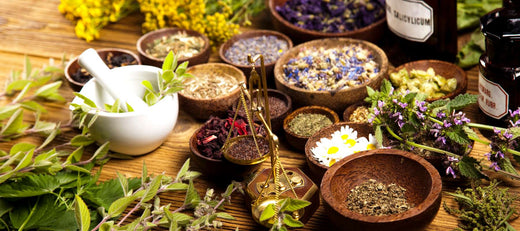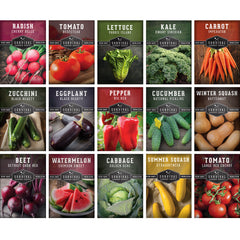As winter approaches and we gather the harvests from our gardens, we must consider how we will use the bounty of our labors. If you have an abundance of crops you would like to store for the colder months, we have some tips and tricks to help you ensure safe long-term harvest storage. Different crops require different methods of storage. Canning, pickling, freezing, drying, and curing are just some of the processes you can use.
Determining Harvest Time
The plants in your garden will have varying harvest times. The ideal time to harvest depends on the plant and the weather.
Herbs
The best time to harvest herbs is usually before they have gone to seed. Harvest leaves and blossoms early in the day when the volatile oils in the plant are at their strongest. Of course, there are some herbs that we harvest specifically for their seeds, like cumin or cilantro (coriander). In that case allow the herbs to flower, seed pods to develop, and mostly dry on the plant before harvesting.
Warm Weather Vegetables
Most of the vegetables that you plant in spring for hot weather like tomatoes, peppers, zucchini, and cucumbers need to be harvested before the first frost. If your weather is cooling down and frost is expected, it is a good idea to pick the fruit from the plants and bring them inside to ripen. Tomatoes and peppers will continue to ripen if placed on a sunny windowsill after picking. Other hot-weather vegetables like eggplant and summer squash may continue to ripen, but may not have the texture or flavor quality that they would have if left to ripen on the vine. You can try placing the under-ripe produce in a paper bag with a ripe banana. The ethylene given off by the banana will help speed the ripening process.
Cool-Weather Crops
Some of our favorite winter vegetables like cauliflower, broccoli, and Brussels sprouts can survive through frost and even some snow. Leafy greens like kale and Swiss chard will taste sweeter once touched with frost. These plants can be added to your garden in the early fall and harvested well into the winter months in most areas.
Food Crop Storage
Canning & Pickling

One popular method of storing food is canning. “Canning” is a bit of a misnomer because most non-commercial canning is done in glass jars, not metal cans. It usually involves applying heat to the food to kill any bacteria and microorganisms. There are two primary canning methods: pressure canning and water bath canning. We discuss these methods in depth in another article. There is almost no limit to the type of foods that can be canned. Just about everything from vegetables and fruits to meat can be preserved with this method.
Pickling is similar to canning in that heat may or may not be involved, but it is a process that extends the shelf life of food primarily by fermentation in brine or immersion in a vinegar solution. The high salt content of brine and high acid content of vinegar prevents microorganisms from multiplying in the food. Pickling often involves the inclusion of spices and herbs that have antimicrobial properties like garlic and mustard. Common pickled foods include cucumbers (pickles), cabbage (sauerkraut), and cabbage with other vegetables (kimchi). They are all anaerobically fermented.
Freezing
Many vegetables will freeze well, the only limitation is freezer space. For beans, peas, broccoli, and cauliflower, chop into bite-sized pieces and blanch in boiling water for 2-3 minutes, then transfer to an ice bath to stop the cooking process. Spread the vegetables to dry and then store them in an airtight container in the freezer. Zucchini and other summer squash can be washed, cut into bite-sized pieces, and frozen. Leafy greens like kale or spinach should be washed and dried thoroughly. Place them in a zip lock bag with a paper towel to absorb extra moisture and freeze. Most frozen vegetables will last 3 to 6 months in the freezer.
Drying & Dehydrating

Air drying and dehydration are easy methods to preserve things like herbs, fruits, and some vegetables. This process works well with things like leafy herbs. Simply hang herbs in a warm dry place until they have thoroughly dried to a state where they are easily crumbled in your hand. Some other things that air dry well include apples, peppers, and tomatoes. String peppers on unwaxed dental floss to hang to dry. Wash and slice apples and tomatoes, spread on a screen with good airflow, and allow to dry. You can then place them in an airtight container and keep them somewhere cool, dry, and away from light until you use them.
A dehydrator can also be used to dry food. Dehydrators usually consist of perforated trays that stack over a heating element. This device simply speeds up the drying process.
Freeze drying is another method of preserving food for a very long period of time. Freeze dryers remove moisture from the food through a process called sublimation. The food is frozen and then vacuum-dried. The vacuum removes the frozen water from the food leaving behind the food with all of its nutrients and flavor. Freeze drying can be used on many types of food that other preservation methods typically do not work on, like dairy products.
Curing

A lot of vegetables come with their own protective layer, so they will store for extended periods without a lot of additional preparation. Vegetables like garlic, onions, and winter squash have a durable outer layer that protects them from rot as long as that layer is allowed to dry out and harden. This is what we call curing.
To cure onions, it is best to cure them indoors so that they will dry evenly. Spread them in an even layer in a well-ventilated warm area. You can also braid the leaves to hang them to dry. You will know onions and garlic are properly cured when the leaves have fully dried and the outer skin is dry and crinkly. This may take 2 to 3 weeks. Once the onions are properly cured, they can be stored somewhere cool and dark with plenty of ventilation.
Winter squash and pumpkins should be harvested before a frost. Check to make sure the fruit is whole and doesn’t have any cracks or split, because this fruit will not last in storage. Once harvested, you can leave them in the garden to cure in the sun for 7 to 14 days or if you are concerned about wildlife or wet weather, bring them indoors and keep them somewhere nice and warm (80°-85°F is ideal). You will know when they are properly cured when a fingernail poked into the rind barely leaves a dent. If you can puncture the skin with a fingernail, it needs more drying time. Like onions, store squash in a cool, dry, well-ventilated area. Make sure not to stack them together and allow plenty of airflow all the way around the fruit.
Cold Storage
Root vegetables like carrots, beets, turnips, and parsnips can be stored for months without a lot of preparation. Remove the leafy tops as they will hold moisture and can rot, do not wash the vegetables. Place them in boxes layered with damp sand that will help the vegetables retain moisture and keep the boxes in a cool dark place like a basement or root cellar. Check periodically for spoilage.
Potatoes should not be washed before storing; just brush off excess dirt and then cure in a dark humid place for 1 to 2 weeks. Spread in a single layer and cover with a damp cloth to enhance humidity. Once cured, place the potatoes in a basket or wooden crate that will allow airflow, alternating with layers of newspaper to keep out light. Then store crates in a cool, dark location like your basement or root cellar. Check potatoes monthly for any signs of rot, as one rotten potato can quickly spoil the whole batch.
Enjoy Your Harvest
You have spent months planning your garden, starting seedlings, planting, and maintaining your garden in hopes of a bountiful harvest. Now that the harvest has come, use simple methods like canning, pickling, freezing, drying, and curing to ensure you and your family can enjoy the fruits of your labors through winter and beyond.

























